I Went To Kyoto
Tuesday, November 29, 2005
Where to even begin? I have so many pictures, and a lot to write, so I suppose the beginning is as good a place as any. Liz and I went to Kyoto last weekend, I suggested it mostly out of guilt that I have been living in Japan for four months now and I've seen exactly two cities, very few of the great sites of Japan, and basically not taking advantage of Japan. We left Friday after work from Mihara (add another city to my list!) and took the hyper-super-express Nozomi Shinkansen bullet train. It makes four stops between Hiroshima and Kyoto, which is about 250 miles. It goes about 190 miles per hour, and it looks fast.
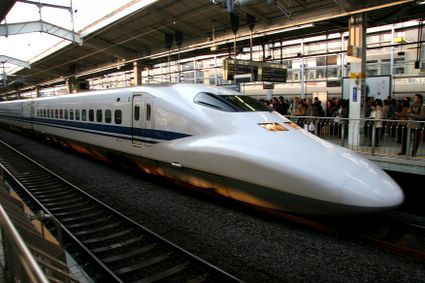
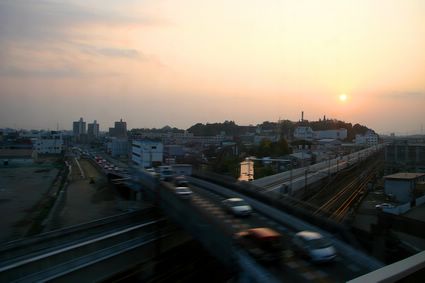
Riding on a train that goes this speed is kind of strange. It feels like you're on an airplane that's just about to take off, you pass cities in about 2-5 minutes depending on how big they are, and the clouds move past at a good speed, not because the wind is blowing but because you are moving fast in relation to them. While we were riding, in the space of a half-hour we got three totally different sunsets because we kept leaving one bunch of clouds behind and coming into another.
Anyway. If I write this much about every picture this is going to be 50 pages long. We got to Kyoto at around 9 at night, and had to make our way to the Gojo Guest House. Not having any idea which way to go, we set off for the buses, ended up on the subway, then on a lonely stretch of street where a Japanese man with perfect English told us that we had gotten off the train at the right stop, but that the guest house was a 20 to 25 minute walk from where we were. We took a cab.
The Gojo Guest house was the sort of place you might hope to spend your first night in Kyoto. An old wood building with a restaurant on the bottom floor, it looked older than anything in Hiroshima (not hard, what with the total annihilation and all). A young Japanese guy met us at the door, and then took us upstairs after we left our shoes in the doorway. Up a steep narrow staircase, there was a long narrow hallway with sliding doors on both sides. On the right was a men's sleeping area, then a women's sleeping area, a lounge ("Here you can watch TV and be relaxed" said our guide.) and a kitchen.
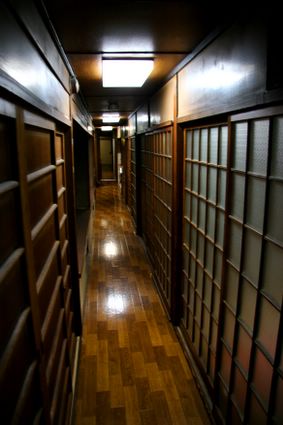
The lounge and sleeping areas were all tatami mat, with sliding panels all around. Each person gets a futon, which you are responsible for making before you go to bed and unmaking when you get up. The room is shared with 5 people. At the risk of going off on a tangent here, a Japanese Futon is not the unfolding couch of American college fame. The futon is the size of a small twin bed, first you lay out an under-futon mat, then a futon, then two small sheets, a blanket, a comforter, and you get a small pillow stuffed with buckwheat chaff. It's comfortable enough, but mostly it's incredibly convenient in a small place because you fold it up in the morning when you wake up, and then your Washitsu room (where the tatami is) is available for whatever else you need. There's no word for bedroom in Japanese for this reason. You have a room that belongs to you, but it's not called a bedroom. We met a fun and diverse group of kids in the lounge (Japan, Italy via Miami Beach, Taiwan) had a beer, ate some chips, got recommendations on where to go, talked about languages, traveling, and got to sleep around midnight.
The next morning we set off for Ginkaku-ji, recommended by the Japanese folks, relatively close on the map, and supposedly very nice and good to see before the crowds get there. We took a train after wrestling with a bus map in Japanese for a good 15 minutes, and ended up (we thought) in the right neighborhood. The map said go east, so we went east. After going through a quiet and sleepy residential neighborhood, agreeing that we were probably lost, and wondering what crazy person designed Kyoto, up ahead we saw some nice trees, a sloping tile roof, and thought our navigation had been spot on.

We found our way in and found a huge temple, with maybe five or ten smaller temples, and surprisingly few people. I didn't question the lack of people, I was perfectly happy to enjoy this place for a little while, sitting on old wood steps, walking on old stone paths, taking pictures.
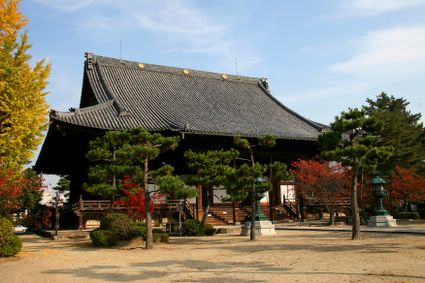
The main building.


I realized when I got back to a computer and looked at these pictures that I had taken a lot of pictures of the roof points (there's got to be a word for them, I don't know it). Enjoy them, I did.
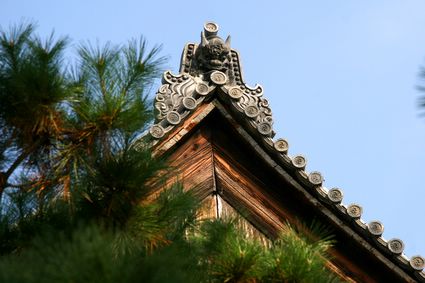
I sat next to a giant brass bell and opened up my guidebook to read about this historic temple I was sitting at. "The buildings connect to paths twisting through a beautiful forest into a mountainside" read I. "A lake and a giant perfectly raked mound of sand are the centerpiece to this perfectly landscaped Feudal Japanese retirement villa." Damn. We hadn't even found Ginkaku-ji. We walked out, made some turns, found Kyoto university and realized we were about a mile away from where we thought we were. That explained the lack of crowds, but when I looked for the temple we had just seen in my guidebook, it rated a couple sentences, practically a footnote.
We walked, we found the place we were looking for, and we certainly did not beat the crowds. I wish I could just post the photos, letting them speak for themselves, and be done with it, it would save me some time, and my fingers are cold. The thing is that the pictures tell a very different story than the experience of being there. Ginkaku-ji, in the high season, is like a theme park that happens to be real. You buy your ticket, you get on the narrow path with everyone else, you jostle for the views with fifty other people who all want to take the same picture, you don't have a single moment of the peace and quiet reflection that this place is dying for. Imagine the most beautiful quiet garden you've ever seen, crisscrossed by winding paths going up and down a mountainside covered in moss and beautiful maple trees. Imagine little streams and waterfalls here and there, a landscaped pond, and a couple ancient buildings sitting serenely at the foot of the hill. Now imagine that all the places to sit down are roped off in order to keep the flow of tourists moving, that the little stone bridges are closed off and there's a guy climbing on the hill with a little broom, sweeping up the leaves that have fallen from the tree. Imagine that the only sounds you can hear are the voices of other tourists, and whenever you stop people bump into you. The experience is decidedly so-so. The thing is, the pictures, the views, all the things you get to keep when you leave, are wonderful. Already the memory of being jostled and steered along a single route is fading, and the pictures I have left are beautiful. It's a dangerous thing, photography. Here they are, views as beautiful as anything I have ever seen in my life, but for everything they do capture, there is so much that they leave out.

Ginkaku-ji and eastern Kyoto in the background.
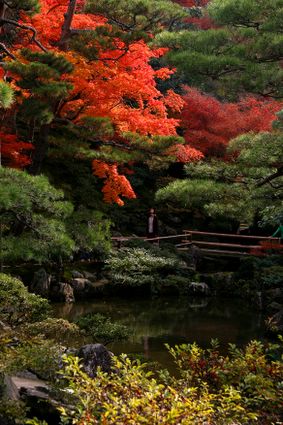

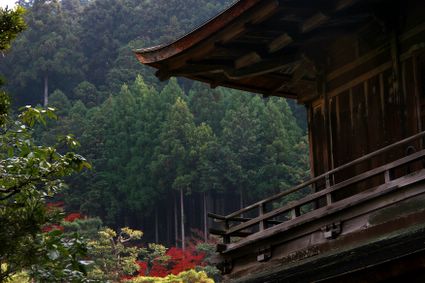
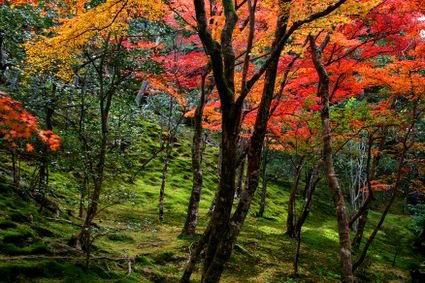
I put my eye to the viewfinder and said to myself "this looks fake." There's a certain point in aesthetics where something is so perfect that it seems like it can't be real.
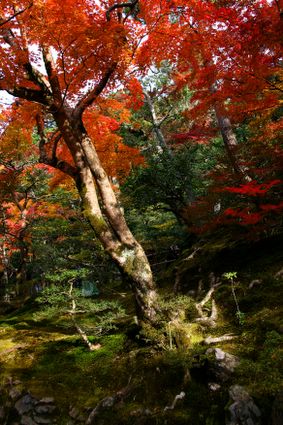

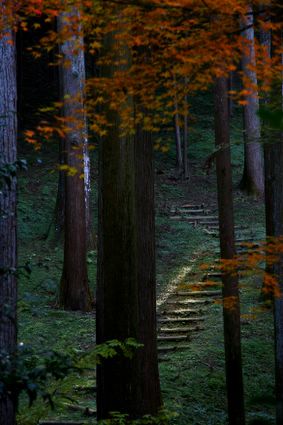
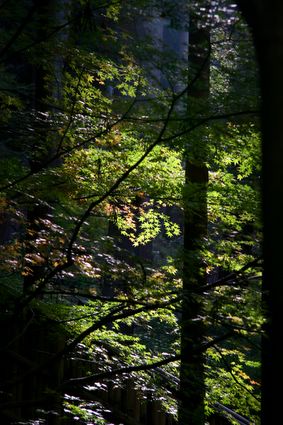
I was aware of the story my pictures were telling while I took them, so I took some pictures that show the stuff I cropped out in most of the pictures.

The path everyone followed, and the average density of tourists. That guy in the scarf looks like he's cold.
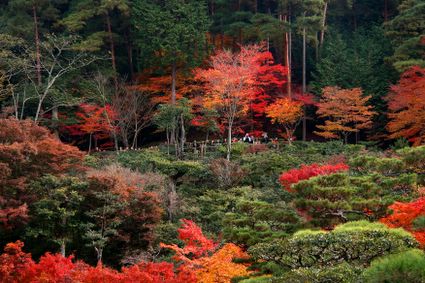
The twisty mountain path. And the five hundred people taking pictures from it.

The entire garden is without grass, it's all moss. VIP moss, as the sign says.
I feel like I've been pretty harsh in this, and I don't think that's quite right. I wasn't hating it as I walked around here, and I am not unhappy with the experience. It's just that a place like this really calls for sitting, wandering alone, maybe having a quiet conversation, and in Liz's words, "It's never going to happen." It's slightly disappointing, but I think there is a solution. You have to get there 20 minutes before it opens, and be the first one through the gates. Charge in, ignore the first few sights, and then slow down. You'll be in front of everyone, and for a few blissful minutes, you'll have the experience you should have.
Kyoto Station is a giant piece of ostentatious architecture for architecture’s sake, full of interesting unused hallways and balconies that serve no purpose. It have about nine thousand escalators, and a pretty much pointless eight story staircase that takes you to a viewing balcony and some ramen shops.

Two floors up, six more to go, looking back. What is that giant round thing? the giant yellow round thing? Oh right, a big thing for no reason.
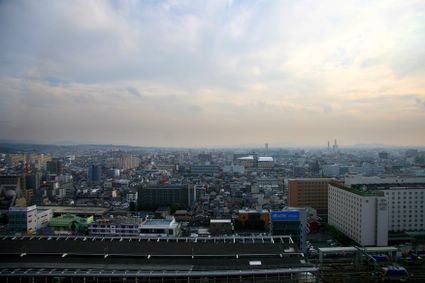
The view from the top is pretty nice. Though Kyoto is the land of temples, they haven't really lasted in the downtown area...
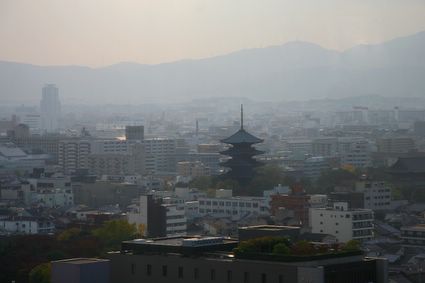
...except this one! I don't know what it is, didn't get a chance to see it, but there it was, posing for me.
At night we got good and lost, but we found a couple cool things.

1. Serious Japanese swords, they start at $2,500, and go up dramatically from there. In a country where guns are completely illegal, it surprises me that you can buy a razor sharp samurai sword and just walk out with it.

2. A traditional meeting house on the river, the top floor was having some function with hundreds of men in suits, and a lot of bowing.
The next morning we vowed to beat the crowds to at least one site, and it paid off. We went to Nijo-jo, one of the oldest castles left in Kyoto. We walked through the gates at a few minutes past eight, and for a good half hour, we basically had the place to ourselves.
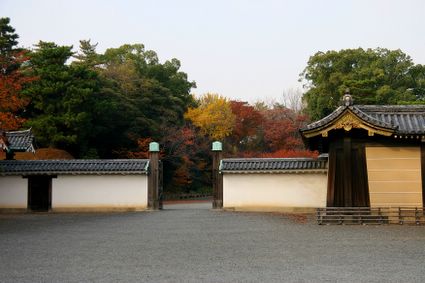
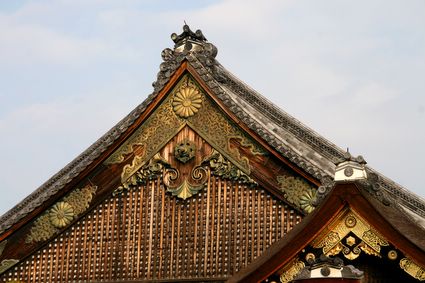
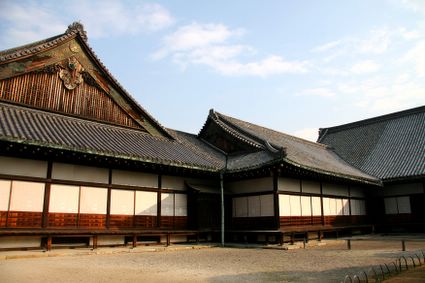
The castle is maybe seven buildings like these, all connected at their corners.
Photography is not allowed inside (neither is sketching, for some reason), but the best part of the inside is the "nightingale" floors. The entire castle is designed so that every floorboard squeaks, making sneaking around and committing nefarious deeds difficult.

The view of the second palace from a tower.

As we got ready to leave, the crowds were arriving, tour buses arriving in convoys, unloading armies of Japanese tourists.

This is what they were after: Momiji, the Japanese maple, which turns brilliant reds and oranges in November.

With what was left of the morning, we headed to Kiyomizu-dera, another of the super famous temples of Kyoto. Crammed on a shuttle bus from Kyoto station, emotionally prepared for the crowds, it was still difficult. The crowds at Ginkaku-ji were at least limited by the narrow walkways. Here was a giant open temple complex, with a giant wooden porch, wide paths, and about five shops for souvenirs and good luck charms. The feeling wasn't quite so amusement park-ish, but it wasn't what the place deserved either.
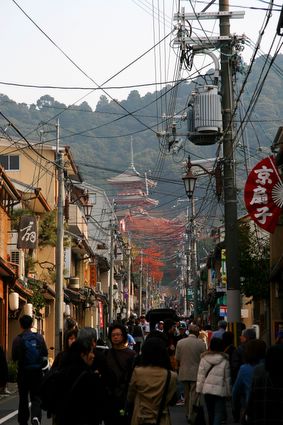
Heading up the street to the temple. That's just the front gate you see there.
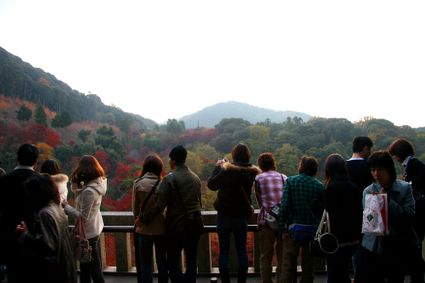
Lining every railing, every high point, every scenic spot, tourists. I realize that I myself am a tourist, and I don't dislike them, I just find that in high volume they can actually take away from the site they are visiting. of course, what they are photographing is breathtakingly beautiful.

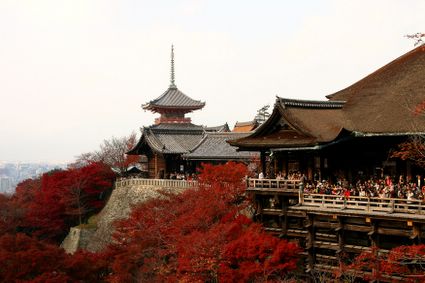
The famous porch, and the infamous crowds.
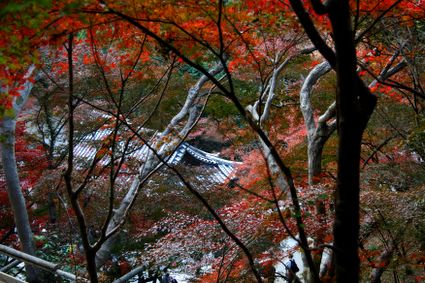
The light kept changing that morning, and some of the pictures have this rust-colored monochrome look that I couldn't recreate if I tried. Call it a happy accident.
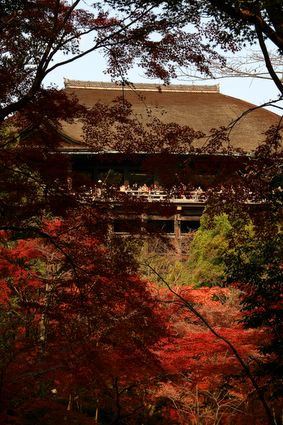
The porch, from below.
And that was it, we had to make a 3:30 train so we got ramen at the station, made sure we weren't forgetting anything, and got the mega-turbo-express home.



Riding on a train that goes this speed is kind of strange. It feels like you're on an airplane that's just about to take off, you pass cities in about 2-5 minutes depending on how big they are, and the clouds move past at a good speed, not because the wind is blowing but because you are moving fast in relation to them. While we were riding, in the space of a half-hour we got three totally different sunsets because we kept leaving one bunch of clouds behind and coming into another.
Anyway. If I write this much about every picture this is going to be 50 pages long. We got to Kyoto at around 9 at night, and had to make our way to the Gojo Guest House. Not having any idea which way to go, we set off for the buses, ended up on the subway, then on a lonely stretch of street where a Japanese man with perfect English told us that we had gotten off the train at the right stop, but that the guest house was a 20 to 25 minute walk from where we were. We took a cab.
The Gojo Guest house was the sort of place you might hope to spend your first night in Kyoto. An old wood building with a restaurant on the bottom floor, it looked older than anything in Hiroshima (not hard, what with the total annihilation and all). A young Japanese guy met us at the door, and then took us upstairs after we left our shoes in the doorway. Up a steep narrow staircase, there was a long narrow hallway with sliding doors on both sides. On the right was a men's sleeping area, then a women's sleeping area, a lounge ("Here you can watch TV and be relaxed" said our guide.) and a kitchen.

The lounge and sleeping areas were all tatami mat, with sliding panels all around. Each person gets a futon, which you are responsible for making before you go to bed and unmaking when you get up. The room is shared with 5 people. At the risk of going off on a tangent here, a Japanese Futon is not the unfolding couch of American college fame. The futon is the size of a small twin bed, first you lay out an under-futon mat, then a futon, then two small sheets, a blanket, a comforter, and you get a small pillow stuffed with buckwheat chaff. It's comfortable enough, but mostly it's incredibly convenient in a small place because you fold it up in the morning when you wake up, and then your Washitsu room (where the tatami is) is available for whatever else you need. There's no word for bedroom in Japanese for this reason. You have a room that belongs to you, but it's not called a bedroom. We met a fun and diverse group of kids in the lounge (Japan, Italy via Miami Beach, Taiwan) had a beer, ate some chips, got recommendations on where to go, talked about languages, traveling, and got to sleep around midnight.
The next morning we set off for Ginkaku-ji, recommended by the Japanese folks, relatively close on the map, and supposedly very nice and good to see before the crowds get there. We took a train after wrestling with a bus map in Japanese for a good 15 minutes, and ended up (we thought) in the right neighborhood. The map said go east, so we went east. After going through a quiet and sleepy residential neighborhood, agreeing that we were probably lost, and wondering what crazy person designed Kyoto, up ahead we saw some nice trees, a sloping tile roof, and thought our navigation had been spot on.

We found our way in and found a huge temple, with maybe five or ten smaller temples, and surprisingly few people. I didn't question the lack of people, I was perfectly happy to enjoy this place for a little while, sitting on old wood steps, walking on old stone paths, taking pictures.

The main building.


I realized when I got back to a computer and looked at these pictures that I had taken a lot of pictures of the roof points (there's got to be a word for them, I don't know it). Enjoy them, I did.

I sat next to a giant brass bell and opened up my guidebook to read about this historic temple I was sitting at. "The buildings connect to paths twisting through a beautiful forest into a mountainside" read I. "A lake and a giant perfectly raked mound of sand are the centerpiece to this perfectly landscaped Feudal Japanese retirement villa." Damn. We hadn't even found Ginkaku-ji. We walked out, made some turns, found Kyoto university and realized we were about a mile away from where we thought we were. That explained the lack of crowds, but when I looked for the temple we had just seen in my guidebook, it rated a couple sentences, practically a footnote.
We walked, we found the place we were looking for, and we certainly did not beat the crowds. I wish I could just post the photos, letting them speak for themselves, and be done with it, it would save me some time, and my fingers are cold. The thing is that the pictures tell a very different story than the experience of being there. Ginkaku-ji, in the high season, is like a theme park that happens to be real. You buy your ticket, you get on the narrow path with everyone else, you jostle for the views with fifty other people who all want to take the same picture, you don't have a single moment of the peace and quiet reflection that this place is dying for. Imagine the most beautiful quiet garden you've ever seen, crisscrossed by winding paths going up and down a mountainside covered in moss and beautiful maple trees. Imagine little streams and waterfalls here and there, a landscaped pond, and a couple ancient buildings sitting serenely at the foot of the hill. Now imagine that all the places to sit down are roped off in order to keep the flow of tourists moving, that the little stone bridges are closed off and there's a guy climbing on the hill with a little broom, sweeping up the leaves that have fallen from the tree. Imagine that the only sounds you can hear are the voices of other tourists, and whenever you stop people bump into you. The experience is decidedly so-so. The thing is, the pictures, the views, all the things you get to keep when you leave, are wonderful. Already the memory of being jostled and steered along a single route is fading, and the pictures I have left are beautiful. It's a dangerous thing, photography. Here they are, views as beautiful as anything I have ever seen in my life, but for everything they do capture, there is so much that they leave out.

Ginkaku-ji and eastern Kyoto in the background.




I put my eye to the viewfinder and said to myself "this looks fake." There's a certain point in aesthetics where something is so perfect that it seems like it can't be real.




I was aware of the story my pictures were telling while I took them, so I took some pictures that show the stuff I cropped out in most of the pictures.

The path everyone followed, and the average density of tourists. That guy in the scarf looks like he's cold.

The twisty mountain path. And the five hundred people taking pictures from it.

The entire garden is without grass, it's all moss. VIP moss, as the sign says.
I feel like I've been pretty harsh in this, and I don't think that's quite right. I wasn't hating it as I walked around here, and I am not unhappy with the experience. It's just that a place like this really calls for sitting, wandering alone, maybe having a quiet conversation, and in Liz's words, "It's never going to happen." It's slightly disappointing, but I think there is a solution. You have to get there 20 minutes before it opens, and be the first one through the gates. Charge in, ignore the first few sights, and then slow down. You'll be in front of everyone, and for a few blissful minutes, you'll have the experience you should have.
Kyoto Station is a giant piece of ostentatious architecture for architecture’s sake, full of interesting unused hallways and balconies that serve no purpose. It have about nine thousand escalators, and a pretty much pointless eight story staircase that takes you to a viewing balcony and some ramen shops.

Two floors up, six more to go, looking back. What is that giant round thing? the giant yellow round thing? Oh right, a big thing for no reason.

The view from the top is pretty nice. Though Kyoto is the land of temples, they haven't really lasted in the downtown area...

...except this one! I don't know what it is, didn't get a chance to see it, but there it was, posing for me.
At night we got good and lost, but we found a couple cool things.

1. Serious Japanese swords, they start at $2,500, and go up dramatically from there. In a country where guns are completely illegal, it surprises me that you can buy a razor sharp samurai sword and just walk out with it.

2. A traditional meeting house on the river, the top floor was having some function with hundreds of men in suits, and a lot of bowing.
The next morning we vowed to beat the crowds to at least one site, and it paid off. We went to Nijo-jo, one of the oldest castles left in Kyoto. We walked through the gates at a few minutes past eight, and for a good half hour, we basically had the place to ourselves.



The castle is maybe seven buildings like these, all connected at their corners.
Photography is not allowed inside (neither is sketching, for some reason), but the best part of the inside is the "nightingale" floors. The entire castle is designed so that every floorboard squeaks, making sneaking around and committing nefarious deeds difficult.

The view of the second palace from a tower.

As we got ready to leave, the crowds were arriving, tour buses arriving in convoys, unloading armies of Japanese tourists.

This is what they were after: Momiji, the Japanese maple, which turns brilliant reds and oranges in November.

With what was left of the morning, we headed to Kiyomizu-dera, another of the super famous temples of Kyoto. Crammed on a shuttle bus from Kyoto station, emotionally prepared for the crowds, it was still difficult. The crowds at Ginkaku-ji were at least limited by the narrow walkways. Here was a giant open temple complex, with a giant wooden porch, wide paths, and about five shops for souvenirs and good luck charms. The feeling wasn't quite so amusement park-ish, but it wasn't what the place deserved either.

Heading up the street to the temple. That's just the front gate you see there.

Lining every railing, every high point, every scenic spot, tourists. I realize that I myself am a tourist, and I don't dislike them, I just find that in high volume they can actually take away from the site they are visiting. of course, what they are photographing is breathtakingly beautiful.


The famous porch, and the infamous crowds.

The light kept changing that morning, and some of the pictures have this rust-colored monochrome look that I couldn't recreate if I tried. Call it a happy accident.

The porch, from below.
And that was it, we had to make a 3:30 train so we got ramen at the station, made sure we weren't forgetting anything, and got the mega-turbo-express home.
